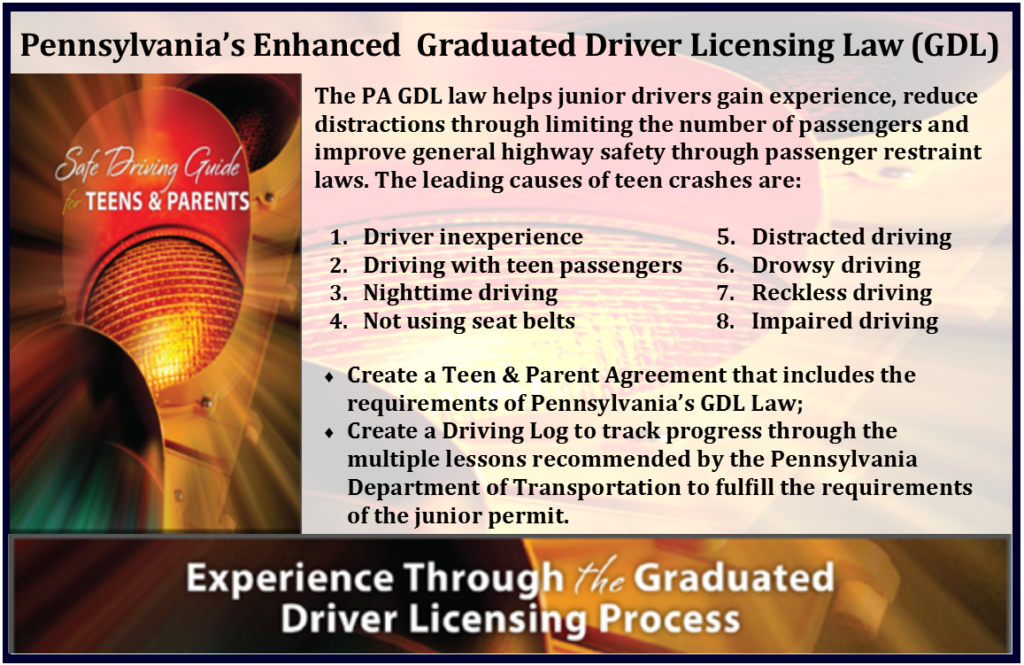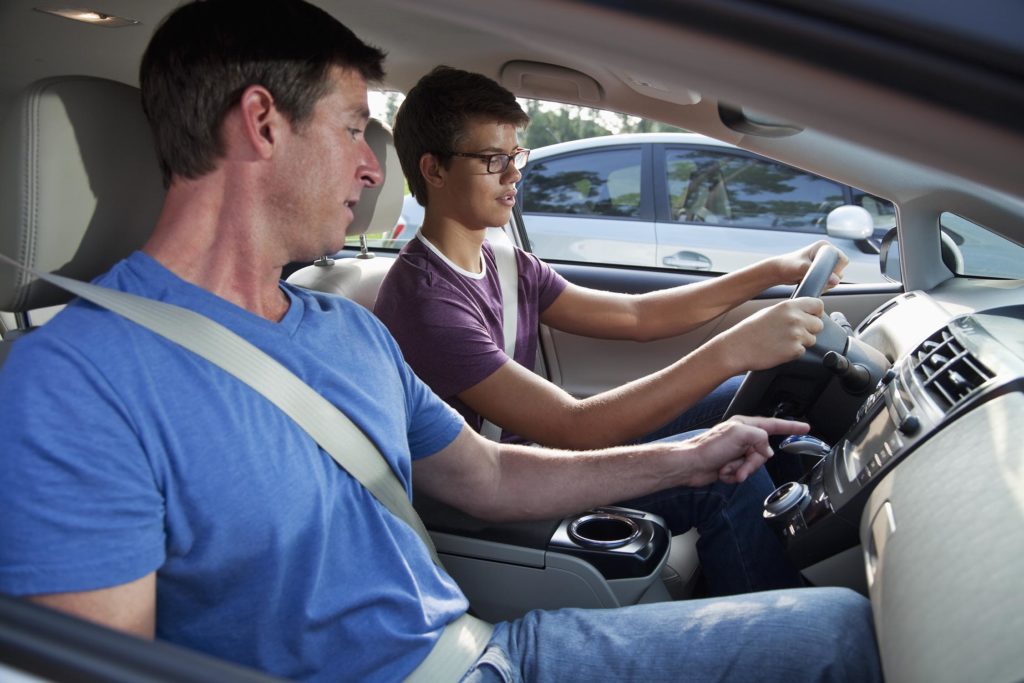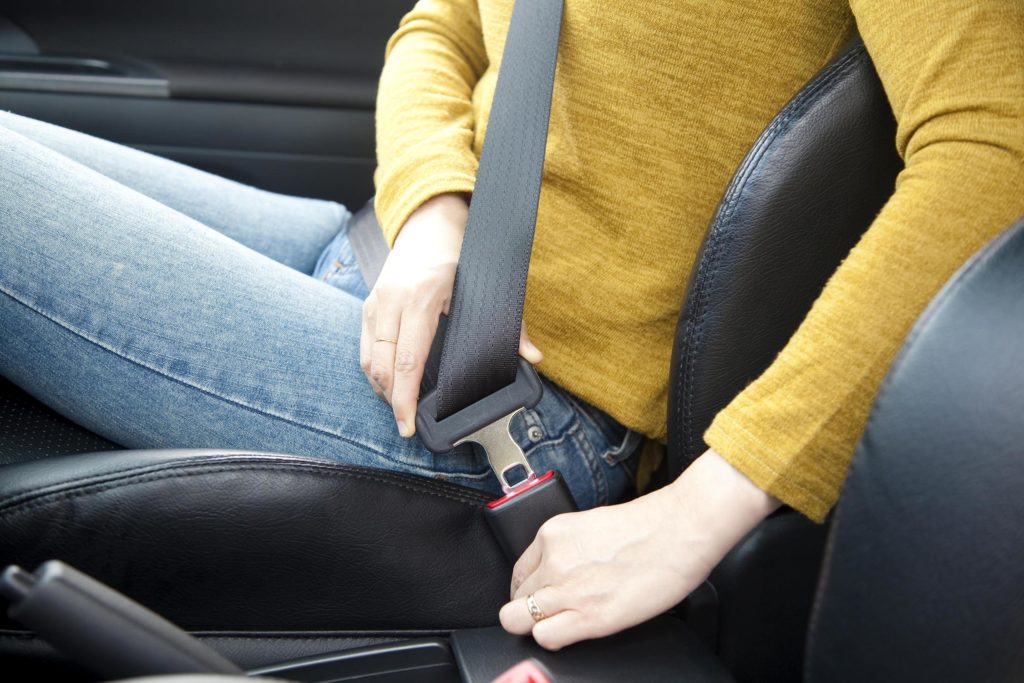Young Drivers
The risk of motor vehicle crashes is over represented among young drivers aged 16 to 19 years of age in crash statistics. Young drivers are at a high risk for crash involvement due to inexperience in recognizing dangerous situations and over confidence in their driving ability.

Pennsylvania Graduated Driving Licensing Law

- Learner’s Permit – Valid for one-year after date of issue:
- Issued at 16 years of age.
- Requires supervision of a licensed driver who is 21 years of age or older, when behind the wheel.
- Requires at least 65 hours of driving. Must include ten (10) hours of driving at night and five (5) hours in bad weather.
- Junior Driver’s License
- Prohibits driving between the hours of 11:00 pm and 5:00 am
- During the first 6 months, passengers are limited to no more than one (1) under the age of 18 unless they are a family member, or the parent or guardian is in the vehicle.
- After six (6) months, passengers are limited to no more than three (3) under the age of 18. If you are involved in a crash or receive a driving violation, the number of passengers will be restricted to one.
- Seat Belt Requirement: Driver’s younger than 18 years of age are required to be secured in a properly adjusted seat belt. The number of passengers must not exceed the number of seat belts in the vehicle and all passengers younger than 18 years of age must be secured.
- Driver’s License issued at age 18 if you have:
- Passed a driver training course approved by the Pennsylvania Department of Education.
- 12 months of driving without a crash or driving violation.
- Consent of parent, guardian or spouse, who is at least 18 years of age.
- Seat Belt Requirement: Driver’s younger than 18 years of age are required to be secured in a properly adjusted seat belt. The number of passengers must not exceed the number of seat belts in the vehicle and all passengers younger than 18 years of age must be secured.
Seat Belts Save Lives

Buckling up is the single most effective thing you can do to protect yourself in a crash. Wearing a seat belt can reduce the risk of a fatal injury by 45%. During a crash, being correctly secured with a seat belt reduces the risk, helping to keep you safe inside your vehicle. Being ejected from the vehicle is almost always more dangerous. Seat belts are vehicle occupants best defense against impaired, aggressive, and distracted drivers. Frontal and side air bags are designed to work with seat belts, not to replace them.
- Place the shoulder belt across the middle of your chest and away from your neck.
- Adjust the lap belt across your hips below your stomach.
- NEVER put the shoulder belt behind your back or under an arm.
5 Ways Seat Belts Protect in a Crash
The appropriate selection of an occupant restraint system is determined by the child’s age, weight, height, and developmental needs. This includes seat belts. An appropriate occupant restraint system protects in 5 ways:
- Preventing ejection from the vehicle:
- People thrown from a vehicle are four times more likely to be killed than those who remain inside. Seat Belts provide the greatest protection against occupant ejection.
- Contacting the strongest parts of the child’s body:
- Seat Belts are designed so that the forces in a crash are absorbed by the strongest areas of your body – the bones of your hips and shoulder.
- Spreading the crash forces across the child’s body:
- A snug lap and shoulder belt spread the force across a large area putting less stress on any one part of the body.
- Providing “ride down” in a crash:
- A quick change in speed is what causes injury.
- Ride down refers to extending the time during a crash that the occupant experiences the slowing down forces.
- The seat belt secures the occupant to the vehicle so the person can take advantage of the extended stopping time/distance provided by the crushing vehicle.
- Protecting the child’s head, neck, and spine:
- A shoulder belt helps to keep the head and upper body away from the hard surfaces inside the vehicle. Seat belts prevent you and other occupants from being thrown into the vehicle, each other, or ejected from the vehicle.
Seat belts protect in a vehicle crash and increase the chance of occupant survival when used correctly. Always:
- Wear the lap and shoulder belt adjusted so it is low and snug across the hips and the shoulder belt is positioned across the center of the chest and shoulder.
- Stay out of the air bag deployment zone. Sit at least 10 inches away from the steering wheel.
- Make sure all passengers are buckled.
Driver Distraction
- Visual Distraction: Taking your eyes off the road.
- Looking at your keypad to type or text instead of looking at the road.
- Auditory Distraction: Listening to something that is not related to driving.
- Having a conversation with other passengers or on the phone while driving.
- Manual distraction: Taking your hands off the steering wheel.
- Manipulating a phone to talk or text.
- Cognitive Distraction: Thinking about something other than driving.
- Daydreaming or lost in thought while driving.
- Some activities involve one or more distractions.
The Myth of Multi-Tasking: The human brain cannot perform two tasks at the same time. The brain does tasks sequentially, switching back and forth. Information in the task not being focused on “falls out of view” both within the mind and the field of vision. Studies have shown the brain needs to re-allocate its resources, showing that listening to a conversation on a cell phone decreased brain activity by 37% in the parietal lobe—the part of the brain associated with driving. The same study also shows a decrease in activity in the occipital lobe—the part of the brain associated with vision.
